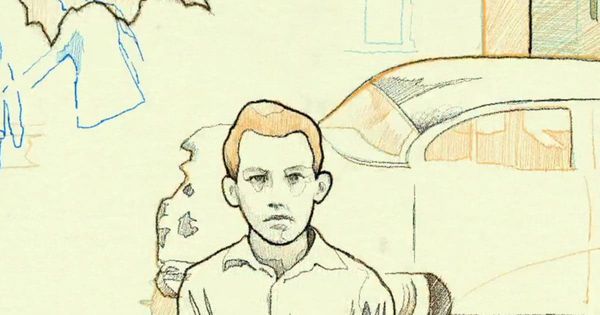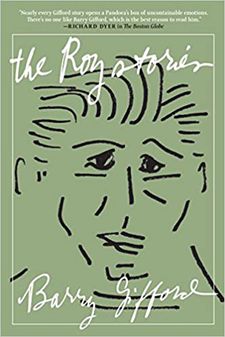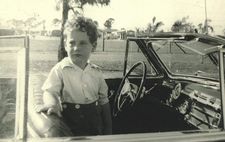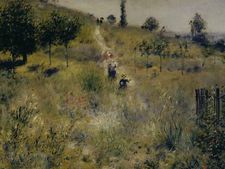 |
| Roy's World: Barry Gifford's Chicago |
Barry Gifford is a name well known to film fans. He wrote David Lynch hit Lost Highway and the novel on which Wild At Heart was based. He’s a celebrated author much admired for his bittersweet portraits of Chicago life. His collected Roy Stories, semi-autobiographical tales about a boy growing up in the city during the Forties and Fifties, were published together for the first time in 2013.
Rob Christopher’s documentary Roy’s World: Barry Gifford’s Chicago, which is screening at this year’s Cheltenham International Film Festival, explores the impact of the Roy Stories and the world they reflect, whilst telling something of Gifford’s own story. Rob and I got talking when his film premièred at the Glasgow Film Festival earlier in the year, and recently connected online to talk about the film. I congratulated him on his study with its high shelves overflowing with books, and asked him why, with so much literary material to choose from, it was Gifford’s work in particular that called to him.
 |
| The collected Roy Stories |
“When I was about 18 I moved to Chicago from the suburbs of Denver, Colorado,” he begins. “It was a gigantic shift moving to a dense urban environment. I moved here for art school and I didn’t really know anything about Chicago but had fallen in love with the city. There’s something about Barry Gifford’s Roy stories that reminded me of what it was like to see Chicago for the first time and experience it with fresh eyes, because that’s how Roy experiences Chicago as he’s growing up, so that was one attraction.”
He didn’t actually read those stories until about a decade ago, he says. “I had already lived in Chicago for quite a while before I even knew that they existed and when I came across them they just blew me away because this was a gigantic mass of stories that sort of explored the city in a way that I wasn’t used to, and that was really exciting.”
Rob used to be on staff at Chicagoist, where he mostly wrote film reviews but occasionally did other kinds of work. one day, he recalls, he came across Barry Gifford’s website and decided to email him to see if he wanted to do an interview. They hit it off and kept in touch over the years that followed, and the idea for the documentary grew out of that.
It’s a film that feels very personal, I observe, with everyone involved coming across as sharing a passion for this subject.
“Willem [Dafoe] and Matt [Dillon] are old friends of Barry’s,” Rob says. “Of course, they’ve worked with him on many projects before. Willem, obviously, played Bobby Peru in Wild At Heart and so was really familiar with Barry’s work. Matt and Barry collaborated on the script for Matt’s directorial début, City Of Ghosts, so they also have a long history of working together. I was just thrilled when Barry suggested these actors and they were both interested and on board, because from my point of view as a filmmaker, they didn’t need much direction. They were really familiar with his work and seemed to plug directly into the spirit of it.
“Lili [Taylor] was an idea I had in the back of my mind because I really felt that the film needed a female narrator – because Roy’s mother is so important to the story – and Matt and Lili had made a film together called Factotum, so through Matt I was able to get in touch with Lili. Interestingly, Lili is from the suburbs of Chicago – a suburb called Glencoe – so she has that Illinois accent that really brings a lot to her readings and performances of the story. Everything just came together in the way that things do if you’re really lucky as a filmmaker.”
There’s also a wonderful jazz soundtrack that really captures the character of that place and time. How did that come about?
“Going back to Chicagoist, another person I interviewed during my time there was Jason Adasiewicz, who’s a local jazz composer and musician and there’s something about his tone that was just really appealing to me. He had never really played in that sort of Fifties style before but I though that if I pushed him a little he might be able to inhabit that space, so what we we did was very early on in the project, even before we started editing, he and I had several discussions about what the moo of the film would be like, and he had a range of moods he wanted to be able to capture. He ended up playing about eight different tunes, so over the course f two days we went into a local recording studio with a crack team of jazz players and we just recorded those eight tunes over and over again in you lots of different ways. Different instrumentation, fast slow, stuff like that, so that I was building up this music library that I could draw upon during the editing... For me it was just the perfect way to make everything be a harmonious collaboration.”
 |
| A favourite memory |
All these things combine to create a strong sense of time and place, yet whilst the film evokes nostalgia – as the stories themselves do – there’s an acknowledgement of racism and sexism that runs throughout. Was it important to Rob to bring that to the surface?
“Absolutely,” he says. “I’ve taken that directly from the stories themselves. For me, one of the most powerful things about Barry’s work in the Roy Stories is that they take a genre – I guess you’d call it a childhood memoir – and rather than wallowing in nostalgia about how everything was so much better and simpler back then, they show warts and all what it was like. Yes, a lot of things were better, but there was also racism, corruption, crime – all of this stuff was going on during his childhood and as Roy is growing up in the stories, so I absolutely wanted to make that a key element in the film.”
What makes the film fascinating in its totality is the way that it explores the relationships between stories and truth and history. Towards the end, a scene about a dream feeds into that larger narrative. Whilst, obviously, this is documentary, was Rob interested in exploring the connections between stories and events and the ways that, perhaps, we can find truth by framing things in different ways?
“I think in the documentary world there’s sometimes an unhealthy obsession with what’s real, what’s not real, what really happened, what is fictional,” Rob says. “I think what I was trying to do almost from the very beginning of the film was to tell you, look, we’re going to be inhabiting a middle ground between ‘history’ and ‘fiction’. I feel that when you can sort of marinade yourself in that middle ground then you find the truth that’s lurking behind both of those things. I think all those elements are playing off each other and then you see the bigger picture.”
Because the film tells the Roy stories and Barry’s story at the same time, there’s a blurring effect whereby, at least part of the time, it’s not entirely clear which we’re hearing about.
“Hopefully at a certain point when you’re watching the film you stop caring about that,” says Rob. “You’re taking it for what it is, and hopefully you can see the deeper truth that’s behind all of those things.”
The film opens with an image of Renoir’s Chemin Montant Dans Les Hautes Herbes, which seems a world away from Gifford’s Chicago but from which fascinating connections emerge. What made Rob choose that image?
 |
| Auguste Renoir's Chemin Montant Dans Les Hautes Herbes |
“I’ve found that some of my best ideas come when I’m in the shower,” he laughs. “When I’m not even thinking about the film, something will just pop into my head, and that’s exactly what happened with that opening scene. What really appealed to me about opening the film that way was, it’s something you’re not expecting as an audience. This is a movie about 1950s Chicago so why are we seeing this painting? I hoped that that would be a way to make sure the audience was alert from the very beginning.”
We talk about the animation in the film, with its eclectic mix of styles.
“Even though the Roy stories as they’re published sort of jump around in time, I thought it would be helpful to chart a vaguely chronological journey of Roy as he grows up, and because he’s growing up, as a character, he’s not the same at age 14 as he is at age five, so I felt it was important to show a story progression, and not only is Roy growing up but we’re moving from the late Forties into the early Sixties, which is obviously the big thing – so I think, visually, that’s sort of what I was going for, a progression, a deepening of the visuals and the character.”
We’re obviously going through an interesting period of history at the moment, with nothing gong quite the way that people expected. How as that impacted his film and what he hopes to do with it?
“My biggest solace is that literally every other filmmaker in the world is going through what I’m going through!” declares Rob. “As disheartening as it is, it’s just the way things are. We premièred at Glasgow and shortly thereafter we screened at the Manchester Film Festival, which unfortunately I was unable to attend. I believe that was basically the last festival in the UK that still went on as planned. pretty much everything shut down after that. Before the pandemic started to affect everything, we had our Chicago première lined up, we had a première in San Francisco lined up – everything was going swimmingly, as they say. Suddenly it was like being on a train and somebody throws on the brakes and the train is just stopped there.
“After catching our breath we’re trying to recalibrate how we’re rolling the film out. As you know, we’re going to be part of Cheltenham International Film Festival, a virtual edition. We have to try some experiments, we have to try some new things to see if there’s still a way to connect with audiences. We’re just going to have to do it a little differently than we thought we were.”
Something I noticed about audience responses to the film’s Glasgow screening was that people seemed to connect with it very strongly despite its specificity. It has a quality that people relate to very easily, especially if they’re from other urban backgrounds.
“I’m not the first person to point this out, but the more specific you are, the more precisely you can capture what a specific time and place look like, the more likely it is that you can capture some universal experience,” says Rob. “That’s really thrilling to me because that’s exactly what I was aiming for.”





















